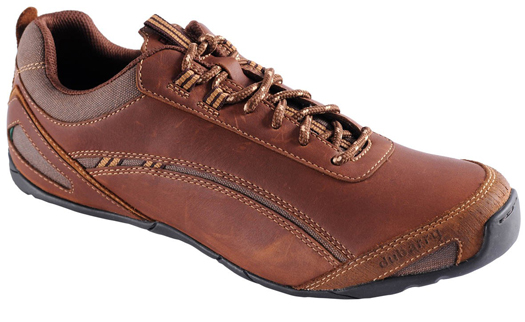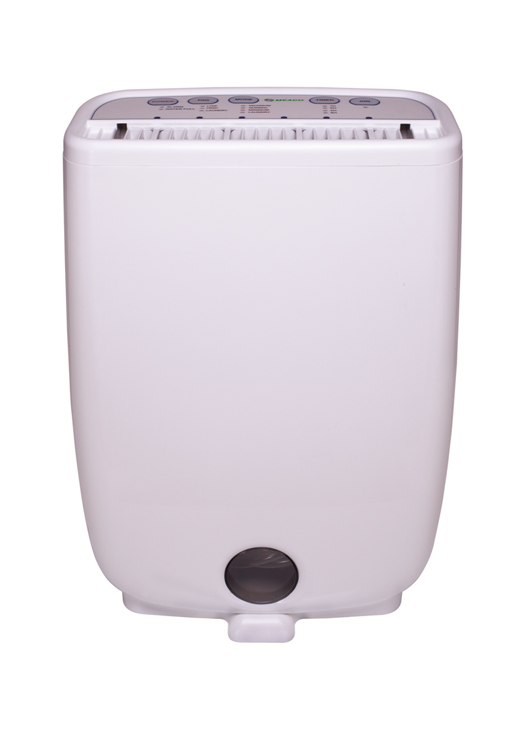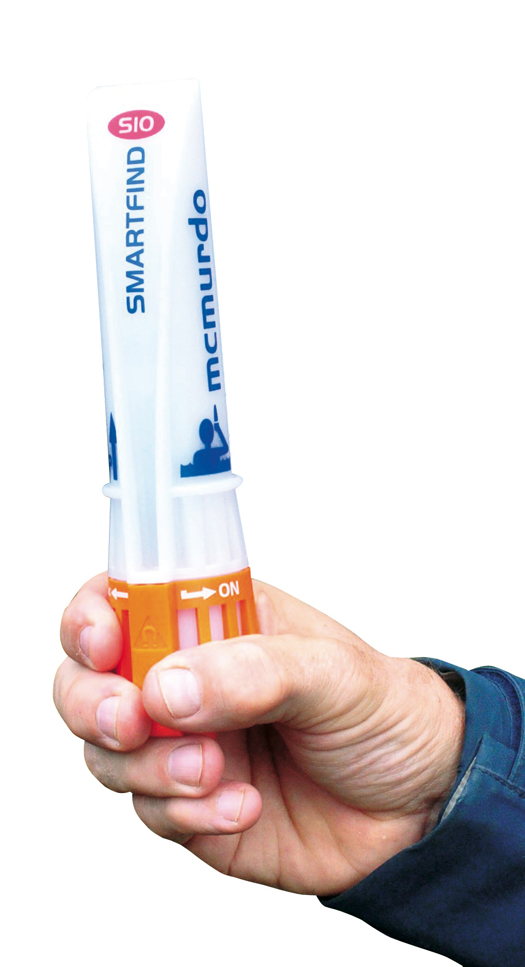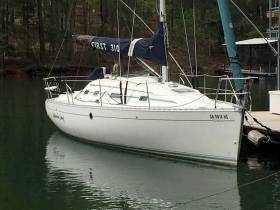Displaying items by tag: marketplace
Beneteau First 310 Packs a Lot of Comfort Into a Classy Figaro Solo Hull
At first glance, the First 310 makes you restless. You sense there’s more to this than meets the eye writes W M Nixon. And you’d be right. The First 310 and her cousins are something else too, as they’re actually based on the Figaro Solo OD.
Of course, as a production cruiser-racer known as the First 310, the former Figaro flyer becomes a slightly more sedate proposition. But oddly enough, it’s when she’s sitting still on calm water with no spray flying around that you realise this Finot-designed cruiser-racer packs a hidden oomph, with beautifully hollowed waterlines forward leading into an easily-driven hull which nevertheless has as much accommodation as a forty footer of yesteryear.
The 310 variant was first produced in 1990 and stayed in production for five years, with Beneteau producing a hundred boats a year. When we add that total (it’s actually 496 boats) to the many boats to the designs which are the Figaro Solo, the First 31.7 which races as a One Design class in Dublin Bay, the Oceanis 300 and the Oceanis Clipper 311 which all share the same basic hull shape, we’re looking at a very impressive fleet which has been giving a lot of people worldwide a considerable amount of sailing pleasure. This is definitely a boat to be saluted.
And there’s one distinctive characteristic of this particular generation of Beneteaus (or should that be Beneteaux?) for which I’ve to confess a weakness. They all feature a circular portlight in the topsides. It’s not some fancy art nouveau mini-window, but a proper circular traditional porthole like you’d find on any genuine classic cruising yacht. Irrational I know, but somehow it speaks eloquently to me of genuine cruising.
In fact, her cruises have been modest enough, but West Cork has frequently seen this boat when she’s not in Dublin Bay doing great things in the racing, as she won the first series this season in Class 5, and has been overall ECHO Champion of the Volvo Dun Laoghaire Regatta and a winner in the Kish Race.
When you add in the cruising option with the proven racing performance, the package becomes complete, as there’s overnight accommodation for six, though if cruised by just three or four, she’d seem luxuriously roomy. This 1990 boat is in Dun Laoghaire and comes with all the best credentials - she has been in the same ownership for ten years, yet recently she got new sails and her standing rigging was renewed. An asking price of €29,950 seems a reasonable deal, details on Afloat.ie sailing cruisers for sale right here.
All Eyes on Dubai for Pre-Owned Boat Show
#TRADE NEWS - Growing demand in the Middle East for pre-owned boats is creating a new market for yacht owners looking to sell, as UAE's The National reports.
This weekend's second-hand boat trade show at Dubai Creek Marina is expecting more than 7,000 visitors to peruse the more than 85 vessels on display, comprising the widest selection of boats for sale.
For this year the retail area has been expanded by 20% to make room for new retailers and exhibitors, including a new zone for personal water craft such as Jet Skis.
"There is a lot more demand [in the Middle East] for second-hand boats than new boats. The market has been growing, we have a lot of people from Qatar, Saudi Arabia, Bahrain who come to Dubai to buy a boat," said marina operations manager Abdulla Ali Al Noon.
It's a market that's being increasingly sought by Irish dealers, too, following MGM Boats' visit to the UAE for the Dubai International Boat Show this past St Patrick's weekend.
One of the companies participating in the pre-owned show this year is Al Marakeb Boat Manufacturing, whose Nour Al Sayyed says: "The crowd at the show are people who already know they're buying a boat, it's just a matter of picking one."
The National has more on the story HERE.
Buying a Boat or Renting: What Are Your Options?
#BUYING A BOAT - With the current economy making everyone think twice before they spend, the question of whether to buy or rent a boat is one being asked more and more often in the marketplace. But what should you consider before you make that decision?
Moose Landing Marina in Maine outlines the main points to be mindful of when you're on the look-out for a new vessel.
First things first is to figure out how often you plan on using your boat. If it's only a few times a year, then perhaps renting would be the most cost-effective option. But if you plan to take it out every week, spending more up front would surely bring you bigger savings in the long run.
If you're new to boating, evaluating the costs will surely be a primary concern. It might be prudent to consider renting for a time while you get your feet wet.
Maintenance should also be considered, as when you buy a boat you're also taking responsibility for its upkeep - making sure all fixtures and fittings are up to scratch and the engine is in clean running order.
Dubarry Reaps Rewards of Forward Thinking Over 30 Years
#MARKETPLACE - "Dog eat dog" competition on the high street prompted Dubarry's managing director to reposition the shoe company as a supplier of premium boating clothing and footwear, as The Irish Times reports.
Eamonn Fagan explains how he saw an opportunity 30 years ago to break the traditional autumn/winter collection cycle by launching a new spring/summer line with boating in mind.
Enter the company's signature Admiral deck shoe, which has since become the firm's biggest seller, with a loyal following among sailors and landlubbers alike.
Since then the company has rolled with the changing tides, such as outsourcing its manufacturing ahead of the curve, which has protected it somewhat from the damage wrought by the economic downturn: profits last year were on the up, thanks to overseas sales, and no jobs have been lost in the recession.
Moreover, it continues to launch new designs, such as the Sligo deck shoe, and also branched into clothing in 2005 with a nautical range that now accounts for around 30% of sales.
“One of the more unusual things about Dubarry is that we largely ignore cost when designing a new product,” says Fagan. “Our view is that if the product is right, we will reap the rewards over time."
It's expected that some of these rewards will be reaped shortly when Dubarry opens a flagship store on Dublin's College Green.
The Irish Times has much more on the story HERE.
Buying From Outside Europe? Make Sure Your Boat is EU Compliant
#BUYING A BOAT - Are you getting value for money when you buy a boat from outside the European Union? Leisure marine website BoatingBusiness takes a look at your options and responsibilities when it comes to importing from abroad.
"Many people underestimate the responsibilities of the importers, distributors and even buyers when they act as importers in Europe," they report, noting that all companies and individuals in the import chain must ensure that any boat coming into the EU complies with the necessary technical, ennvironmental and safety requirements for recreational craft.
To this end, the European Boating Industry has published a handy checklist that allows individual importers and distribution businesses alike to determine if their non-EU boat complies with EU regulations.
Items on the checklust include the boat builder's plate, which must include a CE marking. Boats must also carry a 14-character Craft Identification Number (CIM), proper engine identification (including a unique engine ID number), an owner's manual and a written Declaration of Conformity.
For vessels from outside the EU or new boat builds designed for non-EU markets, those putting them on the marketplace are responsible for arranging a post-construction conformity assessment to ensure compliance with EU rules.
Faulire to comply with these rules could see your boat suspended from circulation or even invalidate your insurance, so it's well worth putting in the effort!
The European Boating Instustry checklist is available as a PDF to read or download HERE.
New Dubarry Sligo Deck Shoe
For over 70 years Dubarry have made footwear...and it's the craftsmanship, quality and style that lie at the heart of our success, a philosophy that's continued through to their latest offering...the Sligo casual sailing shoe.
Dubarry Sligo, a low profile, lightweight casual sailing shoes made from Dubarry DrySoft - DryFast Leathers mixed with waxed canvas. It has the Dubarry award winning NonSlip NonMarking rubber outsole and has a removable EVA insock which provides arch support. Its a 6 eye tie lacing.
The Sligo is available online from dubarry.us or from your local Dubarry stockist.

Rectangular Liferaft Range Launched by Crewsaver
#LIFERAFT– Crewsaver launched its new range of high quality, innovative liferafts in the Watersports Action Pool at last week's Tullett Prebon London Boat Show 2012.
The Crewsaver ISO Ocean Liferaft range has been specifically designed, fully tested and certified to meet stringent ISO standard for inflatable liferafts.
Available in five sizes the Crewsaver ISO Ocean Liferaft can accommodate from four to twelve persons depending upon the model. When activated, the raft inflates quickly (see video below) to form a rectangular or hexagonal shape depending on the size.
As essential safety features, the entire raft is finished in a hi-vis orange colour and has an interior and exterior light to ensure optimum visibility. Other safety features
include large water ballast pockets and a semi rigid boarding ramp to aid people's access
New Meaco’s Dehumidifier From CH Marine
Boat owners prefer this type of dehumidifier to compressor dehumidifiers because they work so much better at low temperatures as they do not care whether the temperature is 10°C or 20°C, their performance remains the same. Whereas a compressor dehumidifier if always less effective as the temperature drops, until it eventually freezes up and ice forms on it's coils.

The DD8L and the DD8L Junior look identical and have the same capacity and performance. The difference is that the DD8L has an air treatment facility with a silver-nano filter to kill bacteria and an ioniser to trap dust/pollen etc in the air. So if someone is living on the boat the DD8L is the better dehumidifier, if no-one is on the boat the DD8L Junior is the cheaper and more sensible choice.
What makes these two dehumidifiers special is that desiccant dehumidifiers, when the relative humidity is reached keep the fan running to sample the air for exceptionally accurate dehumidification. On a boat, because the air volume is small, this is not really necessary and having the fan constantly running pushes up the electricity bill, often at rates higher than the normal domestic average tariff.
Meaco have, therefore, made these two new dehumidifiers more intelligent. When the relative humidity is reached the dehumidifier will sample the air for 5 more minutes and will then turn itself off completely. Rather than just stay asleep and maybe miss the relative humidity increasing and being absorbed by organic material, the DD8L and DD8L Junior turn their fan on every 30 minutes for 5 minutes to sample the air. If the relative humidity is still low they go back to sleep, if the relative humidity has increased they start dehumidifying again.
This provides the perfect compromise between accurate dehumidification and energy saving.
If a boat is well sealed and there is no human activity then there is no reason why the relative humidity should increase too fast. Therefore the dehumidifier will only be on for 10 minutes in every sixty, rather than the old method of being on for a continuous 60 minutes. Therefore potentially these new models will use 1/6th of the electricity of the old models.
Both models feature the standard Meaco features for boat dehumidifiers, i.e., no castors so that they do not roll around, lightweight, a hose in the box for continuous drainage, auto restart after a power cut and a laundry drying mode, and whisper quiet mode for those living on board.
The Meaco DD8L is €199.00 and the Meaco DD8L Junior is €169 both including delivery and VAT. These new models will land in the Ireland at the end of October.
For more information on Meaco Products in Ireland, please contact CH Marine Ltd Tel 028 23190 E-mail [email protected]
New McMurdo Smartfind Gets EU Approval
McMurdo's new Smartfind S10 AIS beacon, an innovative personnel/crew recovery device, has now been approved for sale throughout the European Union. The approval has been given following an independent assessment by the British Approvals Board of Telecommunications (BABT).
The Smartfind S10 AIS Beacon uses AIS (Automatic Identification System) and GPS technology to give precise location information to aid the recovery of persons in difficulty at sea. The Smartfind S10 AIS Beacon will now carry the distinctive CE approval mark, assuring users of its high quality standards. The approval recognises that McMurdo's Smartfind S10 AIS Beacon complies with all essential requirements of the Radio and Telecommunications Terminal Equipment (R&TTE) Directive 1999/5/EC, the main route to compliance for all radio and telecommunications equipment sold in Europe.
The easy-to-activate product is ideal for use by divers, boat crews, or anyone else spending time on or near the water. Waterproof to 60m, as well as buoyant and compact, once activated, the Smartfind S10 AIS Beacon transmits structured alert message to AIS equipment onboard the vessel the individual has come from, and other AIS equipped vessels within a typical 4 mile radius. These messages indicate the precise location of the casualty together with course and bearing to that location. This information can significantly reduce the time it takes to search for and rescue a person in difficulty at sea. The Smartfind S10 uses its inbuilt GPS receiver to regularly update its position information, and has a minimum transmission time of 24 hours, making it a reliable and effective personal safety product for both commercial and leisure users. Available from CH Marine Ltd, tel.028 23190. e-mail, [email protected]. Price €249.99 inc.VAT

New App Shows the Racing Rules
American firm DP Associates has announced the launch of You-Tack! Pro, The Racing Sailor’s Illustrated Guide. Easily understood, it has extraordinary 3D animated quizzes and brilliant illustrations. You-Tack! Pro is available at the iTunes Store for $19.95. (You-Tack! Lite, a free demo, highlighting the major features, is also available – on the iTunes Store by 06/30).
Major Features:The Official ISAF Rules and Definitions with colorful clear illustrations, simple, direct explanations and hyperlinked citations, that make the rules easy to understand. Included for quick reference are all the rules from Part 1 through Part 7, with the appendices A thru D.Forty-two quizzes with vivid “you are there” 3D animations, in seven distinct categories: The Start, Sailing Upwind, The Upwind Mark, Sailing Downwind, The Downwind Mark, The Finish, and Signals.
Each quiz contains: a fact-based Situation, an Illustrated Question, and a 3D Animation. Answer the quiz to find out if you’re right, and review the rationale behind the answer, while a Scoreboard tracks all your answers, and points you to a list of the rules you missed.After completing a quiz, the specific rules and definitions discussed in each quiz are displayed for review.All the racing signals are explained in detail with brilliant graphics, including images of all the international signal flags.No other Racing Rules app comes close!
You-Tack! Pro could be used as a teaching tool for junior programs (run it on the iPod), and a fun clubhouse method for crews looking to build rules knowledge. You-Tack! Pro makes learning the Racing Rules of Sailing easy, and fun. Created by racing sailors for racing sailors, whether the boat you sail is a maxi-yacht, a beer-can racer or a one-design dinghy, You-Tack! Pro is the quickest and most convenient way to build racing confidence, with increased rules knowledge.
To purchase You-Tack! Pro, or to download the demo, You-Tack! Lite, please visit the iTunes App Store.
It highlights and examples the features and functionality of You-Tack! Pro - including a fully indexed listing of all the rules, (displaying the specific details, illustrations and explanations of Rules 1 to 13). Featured are two 3D animated quizzes, all the signals, and all the definitions. It’s a free and easy way to see how the quizzes and the 3D animations function, and how the rules are illustrated in the Pro version.
More on: [email protected], 212-941-1441, or 917-417-3728






































































